Related Research Articles
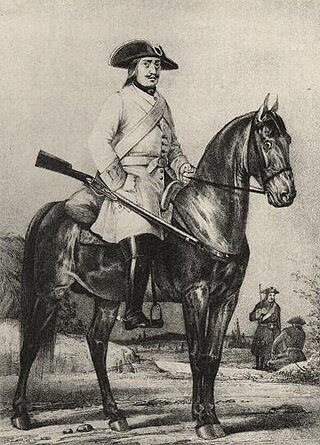
Dragoons were originally a class of mounted infantry, who used horses for mobility, but dismounted to fight on foot. From the early 17th century onward, dragoons were increasingly also employed as conventional cavalry and trained for combat with swords and firearms from horseback. While their use goes back to the late 16th century, dragoon regiments were established in most European armies during the 17th and early 18th centuries; they provided greater mobility than regular infantry but were far less expensive than cavalry.

A grenadier was historically an assault-specialist soldier who threw hand grenades in siege operation battles. The distinct combat function of the grenadier was established in the mid-17th century, when grenadiers were recruited from among the strongest and largest soldiers. By the 18th century, the grenadier dedicated to throwing hand grenades had become a less necessary specialist, yet in battle, the grenadiers were the physically robust soldiers who led vanguard assaults, such as storming fortifications in the course of siege warfare.

Jäger is a German military term referring to specific light infantry units.
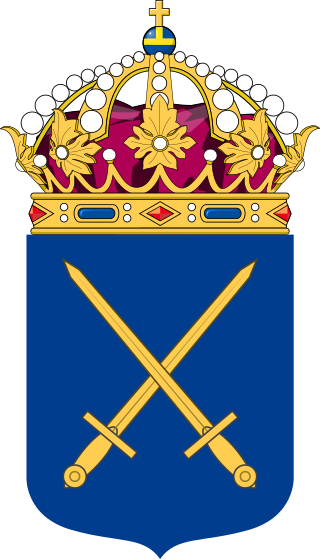
The Swedish Army is the land force of the Swedish Armed Forces of the Kingdom of Sweden in Northern Europe / Scandinavia. The army's history dates back to the Swedish War of Liberation in 1521.
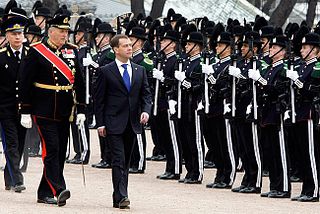
In some militaries, foot guards are senior infantry regiments. Foot guards are commonly responsible for guarding royal families or other state leaders, and they also often perform ceremonial duties accordingly, but at the same time are combat soldiers.
Ensign is a junior rank of a commissioned officer in the armed forces of some countries, normally in the infantry or navy. As the junior officer in an infantry regiment was traditionally the carrier of the regimental colours, the rank acquired the name. This rank has generally been replaced in army ranks by second lieutenant. Ensigns were generally the lowest-ranking commissioned officer, except where the rank of subaltern existed. In contrast, the Arab rank of ensign, لواء, liwa', derives from the command of units with an ensign, not the carrier of such a unit's ensign, and is today the equivalent of a major general.

A bearskin is a tall fur cap derived from mitre caps worn by grenadier units in the 17th and 18th centuries. Initially worn by only grenadiers, bearskins were later used by several other military units in the 19th century. The bearskin cap continued to see use in battle during the mid-19th century, although by the 20th century, it was only used for parade dress. In the 21st century, the bearskin cap is retained by select military units as a prominent element of their ceremonial and full dress uniforms.
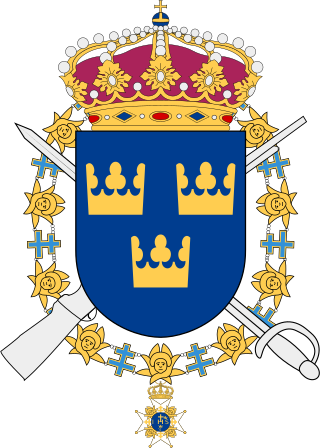
The Life Guards is a combined Swedish Army cavalry/infantry regiment. Its responsibilities include the defence of Stockholm as well as provision of the royal guard of honour for the King of Sweden and the Stockholm Palace. With traditions dating from 1521, the regiment is one of the oldest military units in continuous operational existence in the world. It was established in its present form in July 2000, following a merger of the Svea Life Guards and the Life Guard Dragoons. Headquarters are mainly located in Brunna north of Kungsängen in Upplands-Bro Municipality and at the "Cavalry Barracks 1" in central Stockholm.

The Jämtland Ranger Corps, is a Swedish Army infantry unit that operated in various forms during the years 1670–1983, 1990–1997, 2000–2005 and 2021–present. The unit was and is located in Östersund Garrison in Östersund.
The Närke-Värmland Regiment was a Swedish Army infantry regiment that traced its origins back to the 16th century. It was split into two new regiments in 1812. The regiment's soldiers were recruited from the provinces of Närke and Värmland.

The Värmland Regiment, designations I 22, I 2 and I 2/Fo 52, was a Swedish Army infantry regiment that traces its origins back to the 16th century. The regiment's soldiers were originally recruited from the province of Värmland, where the unit was later garrisoned. The unit was disbanded as a result of the disarmament policies set forward in the Defence Act of 2000.

The Russian Imperial Guard, officially known as the Leib Guard were military units serving as personal guards of the Emperor of Russia. Peter the Great founded the first such units in 1683, to replace the politically motivated Streltsy. The Imperial Guard subsequently increased in size and diversity to become an elite corps of all branches within the Imperial Army rather than Household troops in direct attendance on the Tsar. Numerous links were however maintained with the Imperial family and the bulk of the regiments of the Imperial Guard were stationed in and around Saint Petersburg in peacetime. The Imperial Guard was disbanded in 1917 following the Russian Revolution.
Oberst is a senior field officer rank in several German-speaking and Scandinavian countries, equivalent to Colonel. It is currently used by both the ground and air forces of Austria, Germany, Switzerland, Denmark, and Norway. The Swedish rank överste is a direct translation, as are the Finnish rank eversti and the Icelandic rank ofursti.
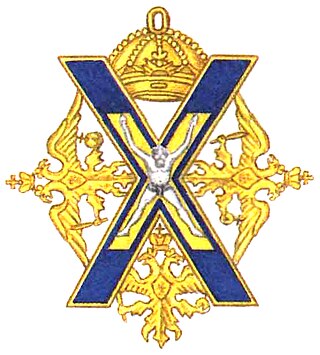
The Preobrazhensky Life-Guards Regiment was a regiment of the Imperial Guard of the Imperial Russian Army from 1683 to 1917.
The Västergötland Cavalry Regiment was a Swedish Army cavalry regiment that traced its origins back to the 16th century. It was reorganized into an infantry regiment in 1811. The regiment's soldiers were recruited from the province of Västergötland.
The Västgöta Regiment, also I 6, was a Swedish Army infantry regiment that traced its origins back to the 16th century. It was converted from a cavalry regiment in 1811 and disbanded in 1927. The regiment's soldiers were recruited from the province of Västergötland, and it was later garrisoned there.

The Air Defence Regiment, is the only anti-aircraft regiment in the Swedish Armed Forces. Its new organisation was introduced in 2000, when all other anti-aircraft units in Sweden were disbanded. The regiment is located in Halmstad and has the responsibility for training two air defence battalions and one home guard battalion.

The Life Guard Dragoons, designated K 1, was a Swedish Army cavalry unit active from 1949 to 2000. The unit was formed as a squadron called the Life Guards Squadron (Livgardesskvadronen) in 1949, as a replacement for the previous K 1, the Life Regiment of Horse (1928–1948). In 1975 the squadron were made into a regiment, titled the Life Guard Dragoons with Stockholm Defence District, redesignated the Life Guard Dragoons in 1984. The regiment had ceremonial mounted cavalry duties, as well as training recruits and providing part of the garrison in Stockholm. In accordance with that year's Defence Act, the regiment was amalgamated into the Life Guards in 2000, thus combining the infantry and cavalry guard units of the Swedish Army.

The Svea Life Guards, also I 1, was a Swedish Army infantry regiment that was active in various forms 1521–2000. The unit was based in the Stockholm Garrison in Stockholm and belonged to the King's Life and Household Troops until 1974.
The Defence Act of 1925 was a defence act passed by the Swedish Riksdag on 26 May 1925 and came into force on 1 January 1928. The Act specified how the Swedish Armed Forces would operate during the coming years. The Act resulted in a policy of disarmament. The Act would remain effective until the Defence Act of 1936.
References
- ↑ "Livkompani" [Life Company]. Förvaltningshistorisk ordbok (in Swedish). Retrieved 11 October 2016.
- ↑ Försvarsmakten. "Enheter på livbataljonen" (in Swedish). Swedish Armed Forces . Retrieved 2018-08-21.